

MartinLogan Montage loudspeaker
Kalman Rubinson and John Atkinson, May, 2005
![]()
This lapsed fan of electrostatic speakers finds it curious that, while MartinLogan is the predominant representative of this technology in the US, I had never auditioned an ML design in my home. I've enjoyed many Janszen tweeters, a KLH 9, an AcousTech X, Stax ELS-F81s, and I've dallied with Quad ESL-63s. But as dumb luck would have it, the first MartinLogan speaker to reach me, the new Montage, is a hybrid model.
 Instead of a electrostatic driver, the Montage mates a pair of aluminum-cone electrodynamic drivers with a magnetically driven planar tweeter. The latter, which MartinLogan calls an ATF Transducer, measures 1.5" by 2.25" and consists of a lightweight film of polyethylene naphthalate film with an etched aluminum voice-coil, which is sandwiched between sets of neodymium-iron-boron magnets in a rigid steel housing. This fully push-pull arrangement is operationally comparable to ML's push-pull electrostatic drivers in its dipolar radiation pattern and in being driven over its entire surface. No external power source is required, but the tweeter's size means that it's crossed over to the midrange-woofers at 2.5kHz rather than operating over close to full range, as in ML's larger electrostatic drivers. On the other hand, the Montage's size, configuration, and finish will make more than a pair of them domestically acceptable in a wider range of homes, as required by multichannel systems.
Instead of a electrostatic driver, the Montage mates a pair of aluminum-cone electrodynamic drivers with a magnetically driven planar tweeter. The latter, which MartinLogan calls an ATF Transducer, measures 1.5" by 2.25" and consists of a lightweight film of polyethylene naphthalate film with an etched aluminum voice-coil, which is sandwiched between sets of neodymium-iron-boron magnets in a rigid steel housing. This fully push-pull arrangement is operationally comparable to ML's push-pull electrostatic drivers in its dipolar radiation pattern and in being driven over its entire surface. No external power source is required, but the tweeter's size means that it's crossed over to the midrange-woofers at 2.5kHz rather than operating over close to full range, as in ML's larger electrostatic drivers. On the other hand, the Montage's size, configuration, and finish will make more than a pair of them domestically acceptable in a wider range of homes, as required by multichannel systems.
Each Montage is a beautifully crafted column with a semi-elliptical plan cross-section sitting on a black base, with a front grille that extends higher than the main enclosure. This characteristic ML design motif covers both cone drivers, and allows the panel-mounted tweeter to radiate freely from both front and rear surfaces. A smaller screen covers the tweeter's rear. The enclosure's top surface slants down to the rear, and its curved back bears a nicely engineered black subpanel encompassing a tapered reflex vent and a recessed pair of connection terminals. The latter are the most finger-friendly terminals I've used permitting absolutely secure connections and disconnections without tools or strain. Spikes are provided as optional replacements for the metal pad feet that come mounted to the speaker's base.
(While the Montage's front grille can be removed by hand, the rear grille is secured by hidden screws. I found this out when one of my review samples arrived with a dead tweeter and MartinLogan sent me a replacement, along with full instructions for its installation. As it turned out, one of the original tweeter's leads had worked free in transit; reattaching it effected a complete cure. But I learned by handling the replacement unit that ML's ATF tweeter is surprisingly weighty and rigid.)
Set-Up
Although the Montage is relatively lightweight and easy to move around, positioning the pair of them took me longer than with most speakers because, above 2.5kHz, the ML operates as a dipole. This means that, in addition to all the issues that apply to conventional monopolar speakers, one must take special care with the speaker's relationship to the wall behind it, as well as the acoustical properties of that wall. A dipole's so-called "room-friendliness" is due to the cancellation of the front and rear waves at the speaker's sides. (Dipoles radiate minimal energy in the plane of the speaker.) In the case of the Montage, however, the fact that it potentially has fewer problems with sidewalls didn't change its interactions with the wall behind the speaker, and its monopole operation at lower frequencies excited important room modes.
I found that the Montage didn't like having any surface or large object near or, especially, close behind it. The AFT tweeter beamed quite a bit within 1–2' of the rear wall, though this was not a problem at listening distances of more than 5–6'. However, there was also a noticeable reflection of the rear radiation bounced from the upper surface of the main cabinet toward my ceiling, which is made of smooth, reinforced concrete. Ceiling treatment or, perhaps, a higher ceiling could fix this. I put a 1"-thick pad of soft, open-celled packing foam on the top of the main cabinet and the issue disappeared.
Sound
For all the controversy about whether or not speakers need to be broken in (ML suggests 30 hours for the Montage), the process was more a matter of my own adaptation and, in going to the Montages from the Revel Ultima Studios, psychological adjustment. (I did switch back and forth, and the distinctions were constant.) After more than 30 hours of speaker and listener exercise, the Montages made lovely sounds and produced a convincing soundstage. The crossover, set close to the human ear's most sensitive range, was pretty much inaudible, with a smooth transition from the monopolar mid-woofers to the dipolar tweeter—as long as I sat more than 2' from the speaker.
This is remarkable—many speakers are notably less successful even when they comprise only transducers of the same basic design. I could appreciate this particularly with female voices, both solo and choral, as the crossover region sits above their fundamentals and in the range of their overtones. An inadequate crossover will corrupt the identifying characteristics of individual voices. The Montage was just wonderful at avoiding this problem. Moreover, the purity and transparency of the highs rivaled that of electrostats as well as other competent magnetoplanar designs.
Nor did there seem to be any imaging anomalies associated with the transition from the monopolar woofers to the dipolar tweeter—just a spacious soundstage notable for its depth and ample width, extending just beyond the speakers themselves (though the height seemed a little less generous than I'd hoped for). The harmonic balance across the spectrum was pretty good, but the Montage was just a bit more forward than I was used to.
This tendency of dipole radiators to "throw" sound into a room made for some spectacular listening experiences. Small jazz combos, in particular, were remarkably lively. Henry Kaiser and Wadada Leo Smith's Yo Miles! Sky Garden two-channel SACD set (Rune 191/192), which is fast becoming one of my standards for definition of instrumental sounds, was recorded with a fixed microphone array direct to DSD as the musicians played live in various combinations. The Montages were great at defining both the characteristic sounds of the individual instruments as well as their distribution in space, almost as if my room was an extension of the studio.
Low-level bass was surprisingly extended for such small drivers in such a compact enclosure. Time and again, with the lowest octaves on piano recordings I was amazed at how the Montage provided a swift kick in the lower bass, even though it's specified down to only just below 50Hz. But this bass felicity was sacrificed when the Montage was pushed to play much louder and/or more complex instrumentation. They didn't complain—power handling was never an issue—but rather became gruff, with a lower-midbass emphasis that overwhelmed the taut extension at the very bottom.
I blame this on the cabinet and port. "Way Down Deep," from Jennifer Warnes' The Hunter (CD, Private Music 01005-82089-2), did indeed go way down deep at moderate levels, with substantial air movement at the rear port and only moderate vibration from all surfaces of the main enclosure. If I turned up the volume to the point where it impressed my friends, the port volume increased a bit but the cabinet vibrations rose in alarming proportion, accompanied by a loss of that delightful bass definition. I didn't remove either mid/bass driver to see how the cabinet was made, but it doesn't matter. Whether a matter of materials or of assembly, no speaker enclosure should vibrate like this unless the design brief is to have the whole thing act as a sound source.
This meant that listening to most recordings of Mahler was out, along with most recordings featuring electric bass—the Montage amplified that instrument out of proportion. I tried Michael Tilson Thomas and the San Francisco Symphony's new SACD of Mahler's Symphony 2, but the bass was off-putting. Of my other Mahler discs, I enjoyed only the lighter textures of Philippe Herreweghe and the Ensemble Musique Oblique's recording of Schoenberg's arrangement for chamber orchestra of Das Lied von der Erde (CD, Harmonia Mundi HMC 901477), and Esa-Pekka Salonen and the LA Philharmonic's lovely Symphony 4 (CD, Sony Classical SK 48380). In Das Lied, the Montages threw a beautiful image of a small ensemble playing with delicacy and precision. Balances between voices and instruments, as well as among the instruments, were quite natural. In Symphony 4, the Montages revealed the presence and beauty of Barbara Hendricks' voice just in front of a very large orchestra spread widely and deeply behind. Clearly, within their limits, the Montages could be open and transparent—but those limits were all too easy to hit.
As best I can remember, the similarly priced Paradigm Reference Studio/60 v.3 speaker, which recently shared the same system—see my December 2004 review—could rarely do what the Montage did best: inspire in me little chills at those moments of clear realism. However, the Paradigm was equally neutral at high and low SPLs, and was consequently easier to live with over the long term.
MartinLogan rates the Montage at 90dB sensitivity and recommends a maximum input of 150W, but the best performance I got from it was with the Classé Omicron monoblocks or a bridged Bel Canto eVo6. These power amplifiers are capable of prodigious outputs, but they also have grippingly tight bass control. With the McCormack DNA-1, rated at 185Wpc, the Montage made the Jekyll/Hyde bass transition at the upper end of the normal listening range I mentioned earlier, forcing me to temper my touch on the volume control. I also restricted my listening to chamber music and acoustic jazz combos—anything scored lightly and transparently. The Montage did a bit better with the Sonic Frontiers Power-3 monoblock. The discipline of pure muscle and high damping factor may be what the Montage needs to keep it well-behaved.
Conclusion
I have two opinions of the MartinLogan Montage.
On the one hand, it is a compact and handsome speaker that, with the right amplification and source material, can present a seamless response, a wide and credible soundstage, and accurate reproduction of voices and instruments.
On the other hand, the Montage exhibited an upper-bass emphasis when driven moderately hard with music of any significant weight. Although this is a flaw in an otherwise compelling design, it should be correctable without starting over. For now, fans of Mahler and heavy metal should stay away; devotees of Diana Krall, the Emerson String Quartet, and Oscar Peterson can love the Montages just as they are.
Sidebar 1: Specifications
Description: Two-way, reflex-loaded, floorstanding loudspeaker. Drive-units: 1.5" by 2.25" dipole film (ATF) tweeter, two 6.5" aluminum-cone woofers. Crossover frequency: 2.5kHz. Frequency response: 47Hz–20kHz, ±3dB. Impedance: 5 ohms. Sensitivity: 90dB/2.83V/m. Maximum amplification: 150W RMS. Flat metal pad and spiked feet provided.
Dimensions: 38" (975mm) H by 9.4" (242mm) W by 11.7" (300mm) D. Weight: 30 lbs (13.6kg).
Finishes: Native cherry and black.
Serial numbers of units reviewed: MTPF 0084, MTPF 0085.
Price: $1495/pair. Approximate number of dealers: 300.
Manufacturer: MartinLogan, 2101 Delaware Street, Lawrence, KS 66046. Tel: (785) 749-0133. Fax: (785) 749-5320. Web: www.martinlogan.com.
Sidebar 2: Associated Equipment
Digital sources: Sony XA-777ES SACD/CD player, McCormack UDP-1 universal player.
Preamplification: Theta Gen.VIII DAC.
Power amplifiers: McCormack DNA-1 (Rev.A), Bel Canto eVo6; Sonic Frontiers Power-3, Classé Omicron monoblocks.
Loudspeakers: Revel Ultima Studio, Paradigm Reference Studio/60 v.3.
Cables: Digital: Stereovox HDVX. Interconnect (all balanced): AudioQuest Cheetah, JPS Super-Conductor 2. Speaker: AudioQuest Granite. AC: JPS Aluminata.— Kalman Rubinson
Sidebar 3: Measurements
The MartinLogan Montage is of just-above-average voltage sensitivity, as an estimated 88.2dB(B)/2.83V/m, which is below the specified 90dB figure. Its impedance plot (fig.1) also indicates that it approaches a 4 ohm load in the midrange and rarely goes above 8 ohms in the treble. The speaker will work best with amplifiers and receivers rated to drive a 4 ohm load.
Kal's primary criticism of the Montage concerned its lack of bass definition at high volumes, which he associated with the cabinet behavior: "If I turned up the volume . . . the port volume increased a bit but the cabinet vibrations rose in alarming proportion." There are two very slight wrinkles in the impedance traces in the 200–400Hz octave, which might be due to resonant modes in the enclosure walls. I therefore fastened a simple piezoelectric plastic-tape accelerometer to various places on the cabinet while I drove the speaker with high-level MLS noise bandwidth-limited to 2kHz.
I found two major resonances on all the enclosure surfaces in this region, at 277Hz and 360Hz, as well as a lower-level mode at around 500Hz. Fig.2, for example, is a waterfall plot calculated from the accelerometer's output while it was fastened to the sidewall level with the lower of the two woofers. The sound file demonstrates the sound of this plot.
It clearly shows all three modes as ridges of delayed energy, with the mode at 277Hz highest in level. It is possible that this behavior correlates with Kal's dissatisfaction with this aspect of the Montage's sound. The resonant behavior remains masked by the music at low levels, but increasingly intrudes as the playback volume increases.
Turning to the frequency domain, the saddle in the impedance magnitude plot (fig.1) indicates that the rear-facing port is tuned to the quite low frequency of 32Hz, which implies good bass extension. The blue and red traces in fig.3 are the nearfield responses of the lower and upper woofer, respectively; both traces show the expected reflex notch in their outputs at the port tuning frequency. (At this tuning frequency, the back pressure from the port resonance effectively holds the woofer cones motionless.) However, the port's response (green trace, scaled in proportion to its radiating diameter) covers a wider bandpass than usual, not rolling off until above 80Hz. The port's output doesn't show any trace of the cabinet resonances, but both woofers show a slight discontinuity in their responses at 277Hz, the frequency of the more powerful resonance in fig.2.
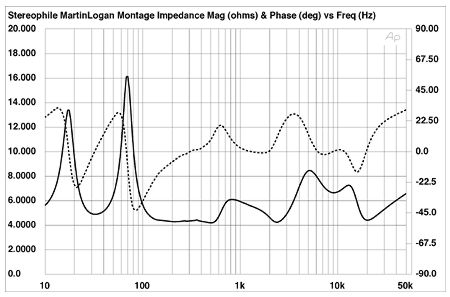
Fig.1 MartinLogan Montage, electrical impedance (solid) and phase (dashed). (2 ohms/vertical div.)
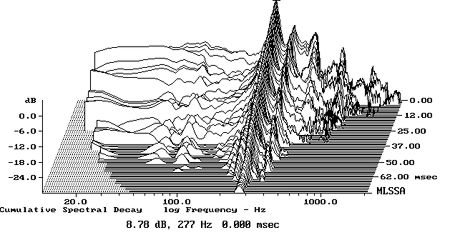
Fig.2 MartinLogan Montage, cumulative spectral-decay plot calculated from the output of an accelerometer fastened to the cabinet's side panel level with the woofer (MLS driving voltage to speaker, 7.55V; measurement bandwidth, 2kHz).
The lower woofer appears to roll off quite steeply above 500Hz, though the upper woofer maintains its upper-midrange output up to the crossover point to the tweeter. The black trace below 300Hz in fig.3 is the complex sum of the three nearfield low-frequency outputs, taking into account acoustic phase and distance from the nominal farfield point. The apparent upper-bass boost in its output is due in part to the nearfield measurement technique, which assumes a 2pi acoustic environment. (See fig.6 in Keith Howard's article on measuring low-frequency loudspeaker response, on p.161 of the April issue.) But this trace does indicate a slightly elevated bass response, to give the illusion that the Montage is larger than it actually is—a common design strategy with relatively small speakers.
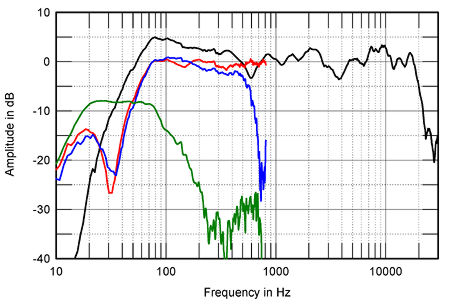
Fig.3 MartinLogan Montage, anechoic response on tweeter axis at 50", averaged across 30º horizontal window and corrected for microphone response, with the complex sum of the nearfield upper-woofer (red), lower-woofer (blue), and port (green) responses, taking into account acoustic phase and distance from the nominal farfield point, plotted below 300Hz.
Moving higher in frequency, the MartinLogan's overall balance is flat in fig.3, though disturbed by some small peaks and dips. The suckout at 600Hz doesn't occur in the behavior of the woofers when measured nearfield. It could well be the result of some partial cancellation of their outputs at the microphone position due to their vertical spacing resulting in different arrival times, in which case it might not be a significant factor in-room.
I originally assumed that the suckout just below 4kHz in this graph was due to the crossover between the upper woofer and the ribbon tweeter. All else being equal, the contrast between this lack of energy and the slight excess in the region immediately below it might explain Kal's feeling that the speaker was "just a bit more forward" than he was used to. But as the bottom trace in the plot of the Montage's vertical dispersion reveals (fig.4), the actual crossover frequency is slightly lower than both 4kHz and the specified 2.5kHz, at close to 2.2kHz. (This plot also reveals that the lower-frequency suckout worsens above the tweeter axis but fills in below it, suggesting that it is indeed due to interference between the vertically separated woofers.) However, this graph indicates that, in the treble, the Montage is relatively tolerant of listener ear height, as long as the listener sits on or above the 35"-high tweeter axis.
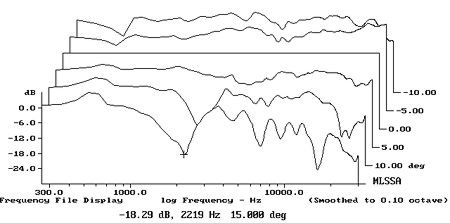
Fig.4 MartinLogan Montage, vertical response family at 50", normalized to response on tweeter axis, from back to front: differences in response 15–5º above axis, reference response, differences in response 5–15º below axis.
In the horizontal plane (fig.5), the Montage offers wide dispersion in the midrange and low treble. There is a lack of off-axis energy in the region of the on-axis treble suckout, however, which will add to the audibility of the energy excess immediately below that region. The tweeter behaves as a dipole above 10kHz, which will make the speaker sound a little mellow in large rooms. Peculiarly, there is a significant off-axis flare between 7kHz and 9kHz, which might also add to the feeling that the speaker has a "forward" balance.
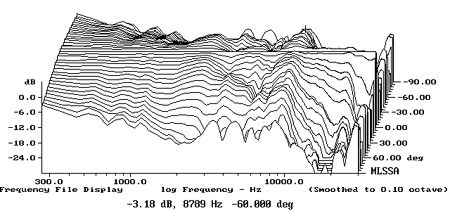
Fig.5 MartinLogan Montage, lateral response family at 50", normalized to response on tweeter axis, from back to front: differences in response 90–5º off–axis, reference response, differences in response 5–90º off-axis.
There are no surprises in the time domain, the Montage's step response (fig.6) revealing that all three drive-units are connected in positive acoustic polarity. The tweeter's output can be seen to arrive first at the microphone, followed by that of the two woofers. The different distances of the woofers from the microphone results in the slight undulations seen in the "tail" of their step, which also manifests itself as the ridge of delayed energy at 600Hz in the cumulative spectral-decay plot (fig.7). The treble region in this graph is commendably clean, however. Kal's positive opinion of this tweeter is well-founded.
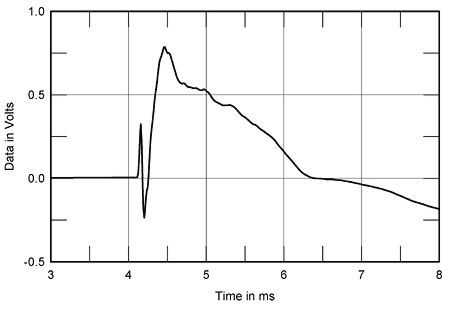
Fig.6 MartinLogan Montage, step response on tweeter axis at 50" (5ms time window, 30kHz bandwidth).
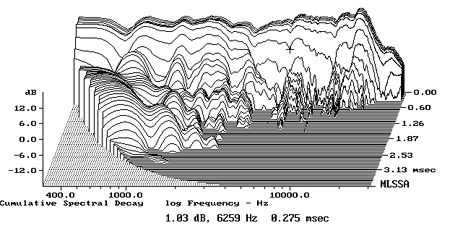
Fig.7 MartinLogan Montage, cumulative spectral-decay plot at 50" (0.15ms risetime).
Taking its affordable price into consideration, the Montage is a well-balanced design, and its appearance is very family-friendly. However, that lively cabinet works against a strong recommendation. I will be writing more on this promising speaker in a "Follow-Up" next month.—John Atkinson
John Atkinson wrote about the Montage in June 2005 (Vol.28 No.6):
Kalman Rubinson was quite taken last month with MartinLogan's affordably priced ($1495/pair) Montage loudspeaker. The floorstanding Montages produced a spacious-sounding, well-defined stereo image, he found, along with a seamless transition between its short ribbon tweeter and the pair of reflex-loaded, metal-cone woofers, and a surprisingly extended bass. However, he was bothered by a lack of low-frequency dynamic range and an upper bass that began to sound gruff when the speaker was handling high levels of complex music, with a "lower-midbass emphasis that overwhelmed the taut extension at the very bottom."
Kal blamed this character on the Montage's cabinet, which vibrated significantly at high playback levels. When I measured the speaker I indeed found some severe cabinet resonances, at 277Hz and 360Hz, as well as a lower-level mode at around 500Hz. However, these are a little high in frequency to affect the upper-bass region; to investigate further, I set up the Montages in my own listening room for some serious auditioning. Amplifiers were Mark Levinson No.33H monoblocks driven by a Levinson No.380S preamp, a No.30.6 D/A processor, and a No.31.5 CD transport. Line-level cabling was all balanced—AudioQuest Cheetah between the source components, Madrigal between pre and power amps—while speaker cable was AudioQuest Kilimanjaro.
For various reasons, I ended up using the MartinLogans for about three weeks. During much of that time, I enjoyed what the speakers did. The soundstaging was indeed well-defined, though with a bit of a splash to the sides in the mid-treble. Like Kal, I found the Montage's treble a trifle forward. There was a bit of mid-treble emphasis, and although this was quite subtle, I felt the two speakers differed slightly in this respect. While this contributed to the sense of the Montage sounding detailed, it did add some hardness at high playback levels to the male voices on Morten Lauridsen's transcendentally tonal "O magnum mysterium," from Comfort and Joy: Volume One, my 2004 recording of Cantus singing Christmas music (CTS-1204).
The speaker's top end was smooth but a little mellow, which, in conjunction with the uncolored mids, made classical piano recordings sound very natural. However, when the piano was already balanced on the forward side, as in the Living Stereo re-release on SACD of Artur Rubinstein's 1954 performance of Brahms' Piano Concerto 1 (RCA Red Seal 82876-66378-2), the sound became a bit too clangy.
It was in the lower registers that the Montage failed to live up the promise of its midrange and treble. The lowest notes of Hyperion Knight's Steinway on Rhapsody (CD, Stereophile STPH010-2) sounded a bit gruff, a little disconnected from the piano's upper registers. Similarly, the lowest notes of Jerome Harris' bass guitar on Rendezvous (CD, Stereophile STPH013-2) didn't quite speak with the same clarity as it did higher in frequency, even at modest playback levels.
Like Kal, I found that the Montage reached its dynamic limits sooner than I was anticipating. During the review period I was working on a new recording of Cantus, Comfort and Joy, Volume Two, the second part of the choir's Christmas music project, due for release in the fall. On one track, the African "Betelehemu," the singers are accompanied by a battery of percussion, including two djembes of different size. The djembe is a relatively small drum held between the player's knees; it is basically designed to be a bass "cannon," producing an enormous wash of low frequencies when struck. Asked to reproduce these drums, the Montage lost definition, blunting the attack and reducing the differentiation of the drums' pitches.
Was it the cabinet resonances that were muddying the sound? When I auditioned the half-note-spaced toneburst track on Editor's Choice (CD, Stereophile STPH016-2), while I could hear the coloring effect of the resonances mentioned above, they were definitely in the lower midrange rather than the upper bass—too high in frequency to explain what Kal and I heard. A mystery.
Measurements: I did perform a couple of additional measurements while I had the speakers in my home. First, I compared the responses of both samples, averaging their farfield outputs across a 30º horizontal window centered on the tweeter axis. The results are shown in fig.1. The response of the sample measured for the May issue is shown in blue, that of the other one of the pair in red. The pair matching is quite good, though the latter does have a flatter output through the mid-treble, as well as more energy above 15kHz.
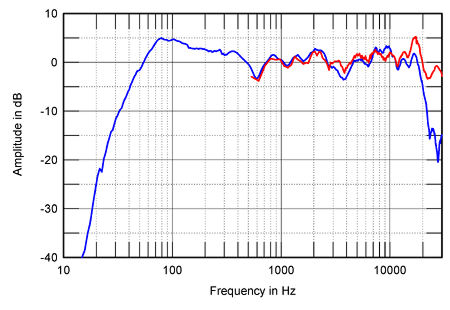
Fig.1 MartinLogan Montage, anechoic response on tweeter axis at 50", averaged across 30º horizontal window and corrected for microphone response, with the complex sum of the nearfield LF responses, taking into account acoustic phase and distance from the nominal farfield point, plotted below 300Hz. Samples MTPF 0084 (red) and 0085 (blue).
Fig.2 shows the Montage's spatially averaged response in my listening room, assessed by taking 120 individual 1/3-octave spectra for the left and right speakers separately, with the microphone positioned in a rectangular grid centered on the position of my ears. Arranging the Montages, with their vertically spaced woofers, at optimal distances from the room boundaries was more tricky than usual; I never could eliminate the slight lack of midrange energy apparent in this graph. Apart from that, however, the Montage's in-room balance was superbly flat, meeting ±1.3dB limits from 450Hz to 11kHz. The slight energy excess at 2kHz correlates with the forward treble Kal and I noted in our auditioning, but given that, if anything, the Montage's output in the 10kHz region is a little high, I am at loss to explain why I thought the speaker mellow-sounding. Perhaps I was being misled by the speaker's grain-free HF presentation.
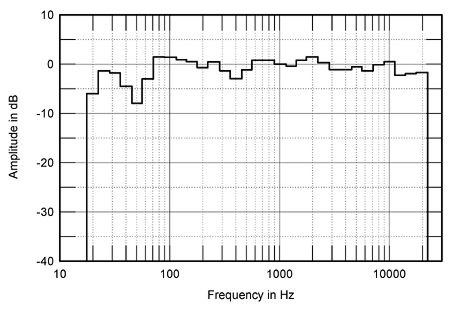
Fig.2 MartinLogan Montage, spatially averaged, 1/3-octave response in JA's listening room.
The low-frequency behavior in fig.2 is dominated by the room acoustics—the suckout at 63Hz is characteristic of my room. If I move my chair forward, this suckout fills in, but at the expense of an even deeper suckout in the 50Hz region, which makes the low-bass sound disconnected. But note that the Montage does produce respectable levels in-room between 25Hz and 40Hz, reflecting the 32Hz tuning of the rear-mounted port and the reinforcement of its output by the adjacent room boundaries.
Summing Up: From my own experience of this speaker's sound quality, I think Kal called it correctly. However, at just under $1500/pair, the MartinLogan Montage is relatively inexpensive, considering its high standard of fit'n'finish, its relatively neutral tonal balance, and its extended in-room low frequencies. In smaller listening rooms, its limited dynamic range may well not be an issue.—John Atkinson
MartinLogan Montage Manufacturer's Comment
Editor: Thank you for reviewing MartinLogan's entry-level Montage floorstanding loudspeaker. The introduction of the MartinLogan ATF drivers found in the Montage has allowed our design and engineering team to achieve excellent levels of performance at prices that, five years ago, even we wouldn't have believed.
Thanks to Kalman Rubinson for his excellent observations regarding the Montage's superior bass extension, clarity, and precision. We agree that the Montage achieves wonderful clarity, precision, resolution, and bass extension at a very modest price.
It is unfortunate that KR experienced bass challenges in his room at high volume levels. This came as a surprise to us, as we have heard no mention of this issue from our dealers, countless ecstatic Montage owners, and the rest of the review community (see Montage review at www.audiorevolution.com).
Thank you once again—we wish you much success in the future.—Gayle Martin Sanders, Founder, MartinLogan